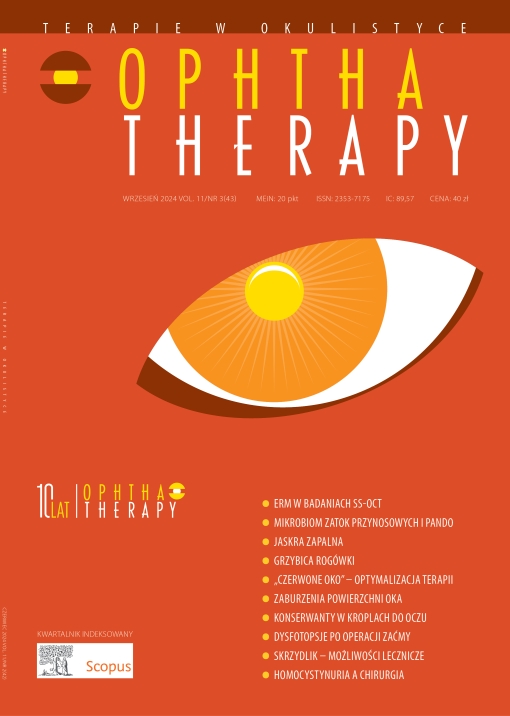Is there a relationship between the microbiome of the paranasal sinuses and nasal cavity and the primary acquired nasolacrimal duct obstruction? Literature review Artykuł przeglądowy
##plugins.themes.bootstrap3.article.main##
Abstrakt
Hormonal factors, atopy, viral infections, gastroesophageal reflux, ischemic heart disease and swimming in a pool are believed to affect the development of primary acquired nasolacrimal duct obstruction (PANDO). It is suggested that patients with PANDO have more advanced inflammatory lesions revealed by the tomographic examination of the paranasal sinuses. The authors’ aim was to answer the question whether there is a connection between the chronic inflammation and disruption of the microbiome of the nasal cavity and sinuses and the development of inflammation in the lacrimal ducts.
Pubmed.gov was the information source. Years reviewed included 2018 to 2023. Inclusion criteria included presence of an abstract, pathology of the nasolacrimal ducts, acute and chronic inflammation of the nasolacrimal ducts, papers written in English, studies on humans, publications regarding pathology of the lacrimal sac and paranasal sinuses, case report. The exclusion criteria included: lack of abstract, pathologies of other sections of the drainage system, pathology of the nasolacrimal ducts, other than chronic or acute inflammation, papers written in a language other than English, lack of case report. No gender criterion was used.
Based on the data available in the literature, only 7 studies described the co-occurrence of pathologies of the lacrimal ducts and paranasal sinuses. Only 4 publications contained information on the microbiome and identified Streptococcus intermedius and Staphylococcus aureus, and in 2 cases no increase in pathological flora was revealed.
The question about the relationship between the microbiome of the lacrimal sac and the paranasal sinuses and their mutual impact on the developing inflammation has not been answered, which, according to the authors, requires further research.
Pobrania
##plugins.themes.bootstrap3.article.details##

Utwór dostępny jest na licencji Creative Commons Uznanie autorstwa – Użycie niekomercyjne – Bez utworów zależnych 4.0 Międzynarodowe.
Copyright: © Medical Education sp. z o.o. License allowing third parties to copy and redistribute the material in any medium or format and to remix, transform, and build upon the material, provided the original work is properly cited and states its license.
Address reprint requests to: Medical Education, Marcin Kuźma (marcin.kuzma@mededu.pl)
Bibliografia
2. Bartley GB. Acquired lacrimal drainage obstruction: an etiologic classification system, case reports, and a review of the literature. Part 1. Ophthal Plast Reconstr Surg. 1992; 8: 237-42.
3. Paulsen FP, Thale AB, Maune S et al. New insights into the pathophysiology of primary acquired dacryostenosis. Ophthalmology. 2001; 108(12): 2329-36.
4. Ali MJ, Paulsen F. Etiopathogenesis of Primary Acquired Nasolacrimal Duct Obstruction: What We Know and What We Need to Know. Ophthalmic Plast Reconstr Surg. 2019; 35: 42633.
5. Linberg JV, McCormick SA. Primary acquired nasolacrimal duct obstruction. A clinicopathologic report and biopsy technique. Ophthalmology. 1986; 93: 1055-63.
6. Yartsev VD, Atkova EL, Rozmanov EO et al. Rhinological Status of Patients with Nasolacrimal Duct Obstruction. Int Arch Otorhinolaryngol. 2021; 26(3): e434-9.
7. Confalonieri F, Balia L, Piscopo R et al. Epiphora and unrecognized paranasal sinuses pathology. Am J Ophthalmol Case Rep. 2020; 19: 100798.
8. Wong E, Leith N, Wilcsek G et al. Endoscopic resection of a huge orbital ethmoidal mucocele masquerading as dacryocystocele. BMJ Case Rep. 2018; 2018: bcr2018226232.
9. Saratziotis A, Zanotti C, Hajiioannou J et al. Agger nasi mucocele cause nasolacrimal duct obstruction and chronic dacryocystitis: clinical profile, management and outcome. BMJ Case Rep. 2021; 14(5): e242140.
10. Ishikawa E, Takahashi Y, Nishimura K et al. Dacryocystitis and Rhinosinusitis Secondary to Sarcoidosis. J Craniofac Surg. 2019; 30(1): e52-4.
11. Takahashi Y, Kono S, Yokoyama T et al. Orbital Abscess Developed Apart From Paranasal Sinusitis and Dacryocystitis in Fibrous Dysplasia. Cureus. 2022; 14(6): e26061.
12. Abdel-Aty A, Jin A, Manes RP et al. Dacryocystitis in a patient with Samter’s triad. Oman J Ophthalmol. 2022; 15(2): 225-7.
13. Rajarajeswari N, Kurien M, Kumar S et al. Bilateral Puffy Orbits in a toddler: Therapeutic Challenges. Indian J Otolaryngol Head Neck Surg. 2022; 74(Suppl 3): 4549-51.
14. Kally PM, Omari A, Schlachter DM et al. Microbial profile of lacrimal system Dacryoliths in American Midwest patient population. Taiwan J Ophthalmol. 2022; 12(3): 330-3.
15. Singh S, James C, Curragh DS et al. Lacrimal gland choristoma in lacrimal sac as a probable cause of nasolacrimal duct obstruction. Clin Exp Ophthalmol. 2019; 47(5): 675-7.
16. Eslami F, Ghasemi Basir HR, Moradi A et al. Microbiological study of dacryocystitis in northwest of Iran. Clin Ophthalmol. 2018; 12: 1859-64.
17. Kim HJ, Lee K, Yoo JB et al. Bacteriological findings and antimicrobial susceptibility in chronic sinusitis with nasal polyp. Acta Otolaryngol. 2006; 126(5): 489-97.
18. Soriano LM, Damasceno NA, Herzog Neto G et al. Comparative study of the clinical profile of chronic dacryocystitis and chronic rhinosinusitis after external dacryocystorhinostomy. Clin Ophthalmol. 2019; 13: 1267-71.
19. Anand Chavadaki J, Raghu K, Patel VI. A Retrospective Study of Establishment of Association Between Deviated Nasal Septum, Sinusitis and Chronic Dacryocystitis. Indian J Otolaryngol Head Neck Surg. 2020; 72(1): 70-3.
20. Samarei R, Samarei V, Aidenloo NS et al. Sinonasal Anatomical Variations and Primary Acquired Nasolacrimal Duct Obstruction: A Single Centre, Case-Control Investigation. Eurasian J Med. 2020; 52(1): 21-4.

